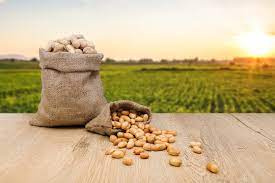The peanut, or groundnut, is a legume crop produced primarily for its edible seeds. The self-pollinating groundnut plant is a member of the Leguminosae family’s Papilionaceae subfamily. An essential oilseed, groundnut is becoming a food crop in India.
A leguminous crop grown for food purposes is groundnut. Due to the seed’s ability to produce oil and the fact that the groundnut crop is classified as an oil crop, it is occasionally thought of as a grain legume. Because groundnuts are self-pollinating plants, they may reproduce without the assistance of bees or other insects that transfer pollen from one plant to another. The first flowers start to bloom 4 to 6 weeks after the seed is planted and continue blooming for 6 or more weeks.
READ – DOWNLOAD GROUNDNUT OIL FEASIBILITY PLAN

Several pests, including infections like viruses, bacteria, nematodes, and most significantly seed-borne fungus, endanger groundnut production. The majority of these diseases are recognized to have an impact on seed quality and viability. Since it is a tropical plant, its growing season must be extended and warm. It thrives in regions with high temperatures, lots of sunshine, and 50 to 125 cm of evenly distributed rainfall during the growing season. The effects of soil temperature on groundnut seed germination, seedling emergence, early plant growth, flowering rate, and pod development are crucial. Low seedling emergence occurs when the soil temperature range falls below 19ºC. Depending on the cultivar, the ideal temperature range for groundnut vegetative growth is between 26 and 30ºC. Maximum reproduction growth occurs between 24 and 27ºC. Due to the need for a month of warm, dry weather, the maximum rate of pod growth occurs between 30 and 34ºC.
Well-drained, light-textured, loose, friable, sandy, and sandy loam soils enable easy penetration of pegs and facilitate the growth and harvest of groundnut plants. For groundnut crops, clay or thick soils are unsuitable because they prevent peg penetration and make harvesting more challenging. Salinity of the soil affects it. It produces well in soil with a pH between 6.0 and 7.5, plenty of calcium, and a reasonable amount of organic matter.
READ – PROFITABILITY OF GROUNDNUT OIL BUSINESS
Propagation of Groundnut

The seeds of groundnuts must be shelled no more than two weeks before to sowing. Groundnut seeds are either immediately sown in the main field or cultivated in the nursery and then transferred there. The seeds must be handled cautiously since they are delicate and easily damaged. The fact that split or broken kernels will never germinate should serve as a strong reminder to only use high-quality seed when planting. The sowing seeds have to have dried naturally. If naturally dried seeds aren’t accessible, artificially dried seeds can be used, however using too much heat to dry the seeds will reduce their ability to germinate.
The size, shape, and color of the testa, or seed coat, vary between groundnut seeds. The testa is paper-like and thin. The testa is composed of three unicellular layers, namely the outer epidermis, also known as the sclerenchyma, middle parenchyma, and inner parenchyma. These layers together serve as the integument of the growing ovule by serving as maternal tissue.
One particularly significant economic characteristic is seed size. Seeds range in size from 5 to 13 mm in diameter and 7 to 21 mm in length. The seed weight, which ranges from 0.17 to 1.24 g, is a key identifying feature. An essential criterion for identifying cultivated groundnuts is the color of the seed coat, which may also have an impact on a cultivar’s marketability. The many grades are hard to uniformly characterize, and the hue is quite subjective. However, this is a crucial genetic trait for diagnostics.
Groundnut seed viability
- The viability of the groundnut seed affects germination, crop stand, and final crop yields.
- Spreading and semi-spreading varieties have dormant seeds, whereas bunch types have non-dormant seeds.
- After reaching maturity, the non-dormant groundnut seeds begin to sprout.
- Before the latent seeds may germinate to their full potential, they often need to rest for 60 to 75 days.
- Ethrel can be used to break dormancy, or you can store seed and maturing bananas for three to four days in airtight containers.
- The non-dormant character of bunch type seed is a disadvantage because if a wet period comes after the seed has reached maturity and crop harvesting is delayed, a significant loss in productivity results from the sprouting of the kernel in the pod itself.
- When it comes to dormant kinds, the seed from the Kharif crop cannot be utilized to grow the rabi or summer crop unless at least three months have passed between the time the Kharif crop matures and the rabi or summer crop is sown.
- Temperature and soil moisture are key determinants of groundnut seed germination. While radical emergence and extension require 50% of water content, germination cannot begin below a seed’s moisture level of 35%.
- Seeds of the bunch and spreading types both germinate between 85 and 90 percent and 90 to 95 percent of the time, respectively. For groundnut, germination rates of less than 85% cannot be deemed good.
- The seed in unshelled pods can remain viable for roughly a year in regions with harsh summers.
- If shelling is done, the seeds rapidly lose viability and become vulnerable to fungus and insect infestations.
- Only a few days prior to planting, seed pods must be shelled, and the seeds must be quickly treated with non-mercurial chemicals.
Groundnuts harvesting process
You may harvest groundnuts mechanically or by stacking them. Groundnuts are lifted, harvested using a combine, prepared in a drying facility, and then set in windrows for mechanized harvesting. The plants are gathered and piled by hand after the taproots have been cut during the stacking procedure. In this process, the plant is made loose so that it may be manually dug out of the ground. When the pods can be separated from the stems without causing lengthy shreds to emerge, groundnuts are then ready for plucking. At this point, the groundnut seeds already taste nutty and rumble when the pods are shaken.
